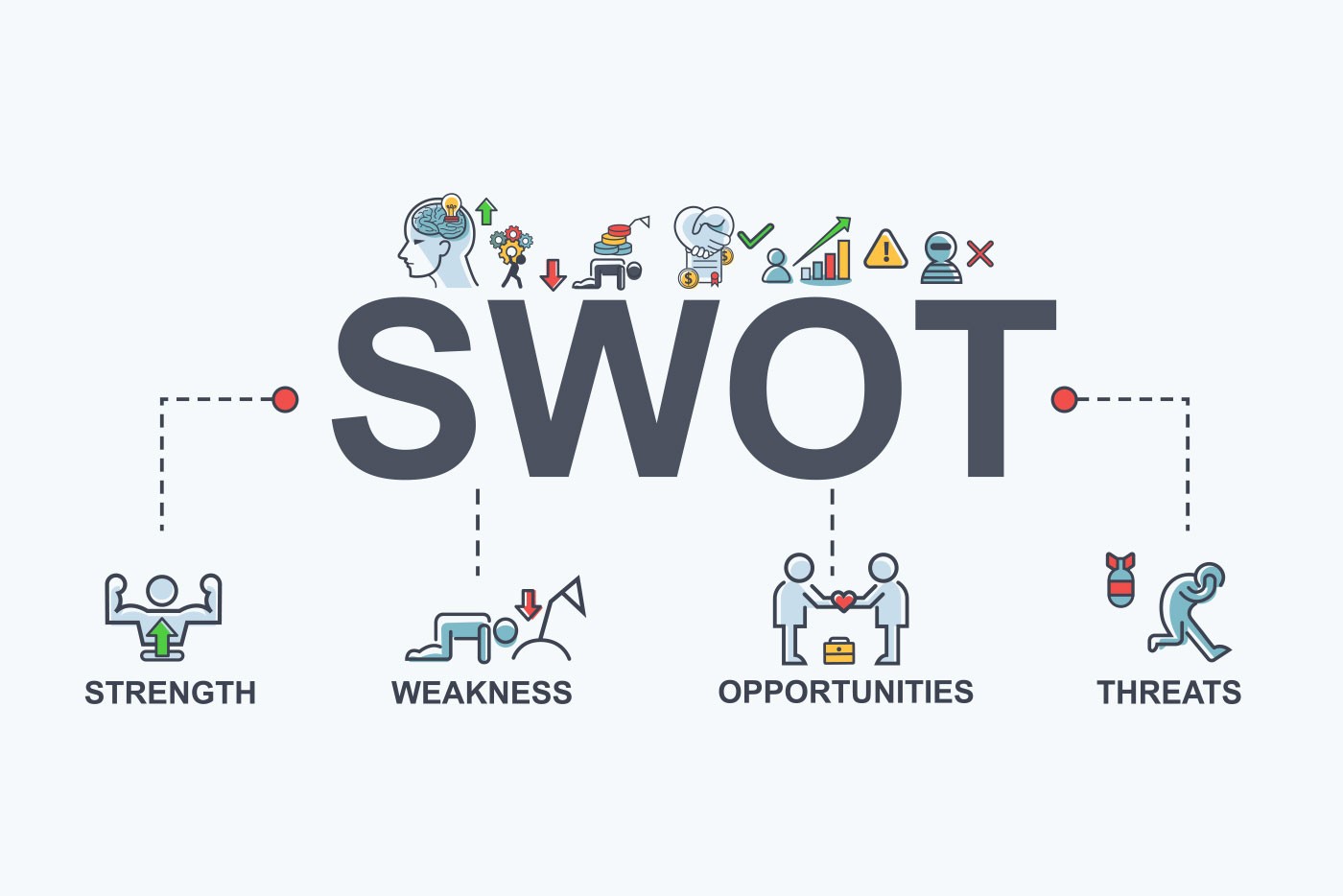Introduction
A SWOT analysis is a technique for assessing these four aspects of your business. SWOT Analysis is a tool that can help you to analyze what your company does best now, and to devise a successful strategy for the future.
A SWOT analysis examines both internal and external factors – that is, what’s going on inside and outside your organization.

A SWOT matrix is a 2×2 grid, with one square for each of the four aspects of SWOT. Each section is headed by some questions to get your thinking started.
While it may seems simple on the surface, a SWOT analysis allows you to make unbiased evaluations on:
- Your business or brand
- Market positioning
- A new project or initiative
- A specific campaign or channel
Practically anything that requires strategic planning, internal or external, can have the SWOT framework applied to it, helping you avoid unnecessary errors down the road from lack of insight.

Strengths
Strengths may be any number of areas or characteristics where a company excels and has a competitive advantage over its peers. Advantages may be more qualitative in nature and therefore difficult to measure (like a great corporate culture, strong brand recognition, proprietary technology, etc.), or they may be more quantitative (like best-in-class margins, above-average inventory turnover, category-leading return on equity, etc.).
Weaknesses
Weaknesses are areas or characteristics where a business is at a competitive disadvantage relative to its peers. Like strengths, these can also be more qualitative or quantitative. Examples include inexperienced management, high employee turnover, low (or declining) margins, and high (or excessive) use of debt as a funding source.
Opportunities
The “Opportunities” section should highlight external factors that represent potential growth or improvement areas for a business. Consider opportunities like a growing total addressable market (TAM), technological advancements that might help improve efficiency, or changes in social norms that are creating new markets or new sub-segments of existing markets.
Threats
Threats are external forces that represent risks to a business and its ability to operate. The categories tend to be similar to the “Opportunities” section, but directionally opposite. Consider examples like an industry in decline (which is the same as a decreasing TAM), technological innovation that could disrupt the existing business and its operations, or evolving social norms that make existing product offerings less attractive to a growing number of consumers.
Uses of SWOT Analysis
Ultimately, a SWOT analysis can measure and tackle both big and small challenges, and opportunities, and both big and little strengths and weaknesses.
While the examples above focus on businesses in general, you can also use a SWOT analysis to evaluate and predict how a singular product will play out in the market.
Hopefully, our SWOT template will supplement your market research and business analysis, and provide fair insights into how to optimize your products for bigger payoffs, and less hurdles.
Consider that findings from a SWOT analysis may help inform model assumptions among analysts. It could be an equity researcher trying to estimate the fair market value of a company’s shares, or a credit analyst looking to better understand a borrower’s creditworthiness.
The SWOT analysis has been a popular business tool for many years. While business planning does require some time and knowledge, most planners agree that a SWOT analysis should be completed at the beginning of the planning process.
Advantages
SWOT Analysis helps in strategic planning in following manner-
- It is a source of information for strategic planning.
- Builds organization’s strengths.
- Reverse its weaknesses.
- Maximize its response to opportunities.
- Overcome organization’s threats.
- It helps in identifying core competencies of the firm.
- It helps in setting of objectives for strategic planning.
- It helps in knowing past, present and future so that by using past and current data, future plans can be chalked out.
Limitations
There are certain limitations of SWOT Analysis which are not in control of management. These include-
- Price increase;
- Inputs/raw materials;
- Government legislation;
- Economic environment;
- Searching a new market for the product which is not having overseas market due to import restrictions; etc.
Subjects of SWOT analysis
- Strengths
Advantages of proposition?
Capabilities?
Competitive advantages?
USP’s (unique selling points)?
Resources, Assets, People?
Experience, knowledge, data?
Financial reserves, likely returns?
Marketing – reach, distribution,
awareness?
Innovative aspects?
Location and geographical?
Price, value, quality?
Accreditations, qualifications,
certifications?
Processes, systems, IT, communications?
Cultural, attitudinal, behavioral?
Management cover, succession? - Weaknesses
Disadvantages of proposition?
Gaps in capabilities?
Lack of competitive strength?
Reputation, presence and reach?
Financials?
Own known vulnerabilities?
Timescales, deadlines and pressures?
Cashflow, start-up cash-drain?
Continuity, supply chain robustness?
Effects on core activities, distraction?
Reliability of data, plan predictability?
Morale, commitment, leadership?
Accreditations, etc?
Processes and systems, etc?
Management cover, succession? - Opportunities
Market developments?
Competitors’ vulnerabilities?
Industry or lifestyle trends?
Technology development and innovation?
Global influences?
New markets, vertical, horizontal?
Niche target markets?
Geographical, export, import?
Market need for new USP’s?
Market response to tactics, e.g., surprise?
Major contracts, tenders?
Business and product development?
Information and research?
Partnerships, agencies, distribution?
Market volume demand trends?
Seasonal, weather, fashion influences? - Threats
Political effects?
Legislative effects?
Environmental effects?
IT developments?
Competitor intentions – various?
Market demand?
New technologies, services, ideas?
Vital contracts and partners?
Obstacles faced?
Insurmountable weaknesses?
Employment market?
Financial and credit pressures?
Economy – home, abroad?
Seasonality, weather effects?
Benefits of a SWOT analysis
What makes SWOT particularly powerful is that, with a little thought, it can help you uncover opportunities that you are well placed to exploit. By understanding the weaknesses of your business, you can manage and eliminate threats that might otherwise catch you unaware.
By using the SWOT framework to look at yourself and your competitors, you can craft a strategy that helps you distinguish yourself from your competitors and better compete against them in your market.
SWOT analysis in a strategic plan
Don’t make the mistake of preparing a SWOT analysis and then ignoring it as you develop your strategic plan. Your plan should include concrete steps to harness your company’s strengths in order to target the opportunities identified in your analysis.
The actions identified as priorities should be incorporated into an action plan that sets a deadline and identifies a person responsible for carrying them out.




